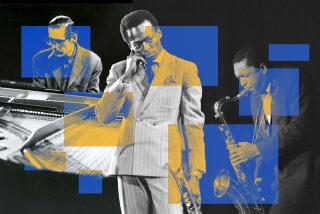JAZZ SPOTLIGHT
Phil Woods and Art Pepper were--along with Lee Konitz and Paul Desmond--were the preeminent white alto saxophonists to emerge in the post-World War II jazz era. If Konitz and Desmond verged toward the cool end of the improvisational spectrum, Woods and Pepper moved in the opposite direction, their playing ignited by strong undercurrents of emotional heat.
Neither ever quite attained the highest level of jazz stardom. Pepperâs erratic career alternated strikingly fertile periods with long, fallow years he spent in prison or debilitated by chronic drug usage. Woods, on the other hand, has worked steadily and productively since the mid-â50s. But his playing has never developed much beyond the pervasive influence of be-bop in general and Charlie Parker in particular.
Two recently released collections illustrate, in exhaustive detail, important segments in the mature work of both musicians.
ART PEPPER
âThe Complete Village Vanguard Sessionsâ
Fantasy
* * * 1/2
Much of the material in this nine-CD boxed assemblage has been previously issued, in a variety of permutations, here and in Japan. But this is the first complete audio documentation of the three nights in late July, 1977, during which Pepper made his live recording debut in New York City. The program includes a number of repetitive versions of the same tunes: three romps through âCherokee,â multiple renderings of three originals (âBlues for Heard,â âMy Friend Johnâ and âFor Freddieâ) as well as a couple of takes on âCaravanâ and a few ballad standards.
Recorded five years before Pepperâs death in 1982, the music is a sometimes painful, often exhilarating view of an artist who--knowing that his life had caught up with him-- threw caution to the wind and simply played from his heart.
By the time he arrived at the final set, much of his soloing had progressed past the riff-centered lines usually characteristic of his work into a language of musical shouts, cries and screams. It is jazz as self-expression and personal catharsis, jazz at its most revealing.
PHIL WOODS
âThe Phil Woods Quartet/Quintet 20th Anniversary Setâ
Mosaic
* * *
Woods has worked with bassist Steve Gilmore and drummer Bill Goodwin for more than 20 years, thus the title of this five-CD anthology. Several piano players, among them Mike Melillo, Hal Galper and Jim McNeely, as well as such front-line associates as Zoot Sims, Tom Harrell and Brian Lynch, have also passed through Woodsâ groups.
But the key element in all the dates, which extend from a 1976 Japanese concert recording on a mono cassette to a 1992 date in Pennsylvania, is the connection among Woods, Gilmore and Goodwin. Only rarely in jazz history have horn players had the opportunity to grow, develop and evolve with the same rhythm team. Compatible from the very beginning, the trio eventually achieved an almost symbiotic interaction.
Woodsâ generally attractive compositional technique has matured considerably, especially during the last decade or so, but his playing remains fairly constant--hard-driving, articulate, fiery-fingered and be-bop-based. To his credit, and despite the limits inherent in the musical arena he has chosen, Woods continues to find and to contribute new creative energies to be-bop, 50 years after the style first appeared.
Mosaic recordings are issued in limited editions by Mosaic Records, 35 Melrose Place, Stamford, Conn. 06902.
Albums are rated one star (poor) to four (excellent).
More to Read
The biggest entertainment stories
Get our big stories about Hollywood, film, television, music, arts, culture and more right in your inbox as soon as they publish.
You may occasionally receive promotional content from the Los Angeles Times.










